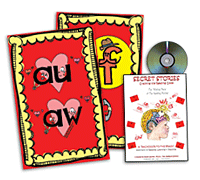Imagine you're a beginning learner in Kindergarten, 1st, or 2nd grade, and you're told about the grown-up reading & writing ""secret" al, and the sound they make when they get together in a word...
A and L love balls!
ALL balls...
Footballs, baseballs, basketballs, volleyballs...
ALL balls, ALL the time!!
Armed with this new reading and writing tool, you naturally begin looking for opportunities to use it, not in a workbook or on a skill sheet, but in real life, just like real grown-ups do!
Take a moment and look around wherever you happen to be. Do you see the al Secret anywhere? Maybe on a newspaper headline, or on a magazine cover? Now imagine the text-rich environment of your classroom where opportunities for spotting this and other Secrets are literally EVERYWHERE!
I'm often asked to create SECRET STORIES® practice pages and skill packs targeting individual Secrets, but aside from the few I've done for the "core" Secrets (i.e. Secrets of the Superhero Vowels®, Spotting Secrets, and Beethoven Blends) I've never felt this was necessary.
The best way to hone new skills is to use them, and the best use of the Secrets is for real-life, learner-driven purposes.... which abound in daily reading and writing! Applying the Secrets on workbook pages can't compare to applying them to the reading and writing activities that are ongoing across the curriculum and throughout the entire instructional day!
The best way to hone new skills is to use them, and the best use of the Secrets is for real-life, learner-driven purposes.... which abound in daily reading and writing! Applying the Secrets on workbook pages can't compare to applying them to the reading and writing activities that are ongoing across the curriculum and throughout the entire instructional day!
And besides, there are so many outstanding and creative resources already available that offer natural reinforcement the Secrets! And since I'll be doing a few guest posts for Deanna Jump this month on her blog, I thought I'm going to use one of her "Chit Chat" units as an example.
One of the best ways to build learner-automaticity with the Secrets is to provide rich, daily literacy experiences and activities that spur learner-interest so as to inspire use of the Secrets. Activities like Mrs. Jump's Chit Chat (or any other flexible "open-ended" learning activity/framework) provide an ideal springboard for use of the Secrets for multi-purpose learning!
A consistent, yet flexible format makes for easy differentiation!
The consistent, and yet flexible format of the activities makes it easier for beginning learners to "multi-process." The open-ended format encourages learners to simultaneously apply the Secrets they know, in conjunction with the individual letter/sound skills targeted (i.e. writing additional words that "start with the letter B" and contain one or more Secrets).
Combing both skill sets for one purpose allows learners to more fully engage with the activities while reinforcing their natural integration (i.e. use of the individual letter sounds and Secrets, simultaneously, rather than having to wait to acquire/apply one before the other.) The result is natural, and thus, easy differentiation for a variety of skill-levels and instruction.
 |
| Mrs. Jump's "Chit-Chat Morning Messages" on TpT! |
These non-fiction Chit Chat units (below)
are rich in content and naturally motivate learners application of the Secrets...
 |
Secret Stories® are literally hiding behind every corner!
More than anything else, what I love most about using the Secrets to read and write across the instructional day is that it clearly demonstrates the power that comes with owning these tools of our language! The Secrets give those who know them power over text!
For beginning learners, the ability to figure out new words on their own, as well as to write the words they want to use in their stories (regardless of whether or not it is on a sight word wall to copy) is an empowering feeling. And it's this "power over text" that ignites learners' desire to read and write MORE!
The better we are at something, the more we like to do it... and the more we do it, the better we get...
and the better we get, the more we love to do it....
The worse we are at something, the less we like to do it... and the less we do it, the worse we get....
and the worse we get, the less we want to do it....
Get the idea?
Secret Stories® can be found around every corner and on every page of any book OR TpT activity! Anywhere there is text, there are an abundance of opportunities for introducing new Secrets and revisiting/reinforcing old ones!
Can you spot the Secrets on this page of Mrs. Jump's Non-Fiction Chit Chat unit below?
(HINT- I've included some "secret: visual clues to help you spot them!)
You can download the FREE Secret Stories® Mini-Anchor Sampling here,
or to view the complete Classroom Kit versions, see the picture link, below.
Until Next Time,
Katie :-)
 |
Never Miss a Secret! Subscribe to the Newsletter! |
Secret Stories® Makes Phonics Make SENSE!
 | |||
|


























